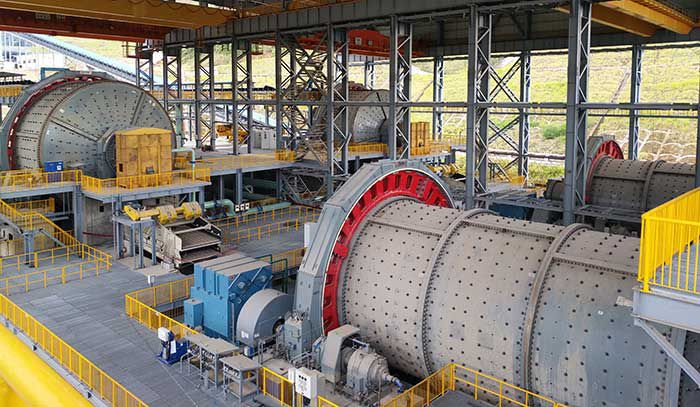As a critical energy-consuming equipment in petrochemical and mining industries, the ball mill plays a pivotal role in material grinding and processing. Despite advancements in permanent magnet direct-drive (PMDD) systems, which enhance operational efficiency and reduce energy consumption, mechanical challenges such as rotor eccentricity and vibration persist. This study focuses on analyzing electromagnetic forces, radial air-gap flux density, and vibration acceleration under varying eccentricity conditions to propose mitigation strategies for improving the stability and longevity of ball mills.

1. Introduction
The ball mill is indispensable for grinding materials post-crushing, widely utilized in petrochemical, mining, and metallurgical sectors. Traditional ball mills suffer from low efficiency (≈82%) due to mechanical transmission components like gears and reducers. Modern PMDD systems eliminate these components, boosting efficiency to over 90% while reducing maintenance costs. However, the integrated rotor-drum design exacerbates rotor eccentricity, leading to uneven air gaps, increased electromagnetic forces, and severe vibration. Addressing these issues is critical to minimizing downtime and optimizing ball mill performance.
2. Research Status of Ball Mills
2.1 Traditional vs. PMDD Ball Mills
The evolution of ball mill technology is summarized below:
| Parameter | Traditional Ball Mill | PMDD Ball Mill |
|---|---|---|
| Efficiency | 82% | >90% |
| Maintenance Cost | High (gears, reducers) | Low |
| Energy Consumption | High | Reduced by 15–20% |
| Vibration Risk | Moderate | High (eccentricity) |
PMDD systems, first commercialized by ABB in 1992, utilize low-speed high-torque permanent magnet synchronous motors (PMSMs) with fractional-slot windings. These designs enhance torque density and reduce material usage but amplify electromagnetic vibration due to harmonic forces.
2.2 Electromagnetic Force and Vibration
Radial electromagnetic forces, particularly at frequencies close to the motor’s natural frequency, intensify vibration. Finite element analysis (FEA) has become the standard for studying these forces. For instance, Yang et al. linked current harmonics to radial force waves, while Zhu et al. established relationships between force wave frequencies and switching frequencies. Mitigation strategies include:
- Optimizing winding configurations.
- Adding auxiliary rotor slots.
- Adjusting pole-slot combinations.
3. Electromagnetic Force Analysis
3.1 Theoretical Framework
Eccentricity in ball mill motors is categorized into three types:
- Static Eccentricity: Caused by assembly errors, resulting in a fixed asymmetric air gap.
- Dynamic Eccentricity: Arises from rotor imbalance or bearing wear, causing rotating asymmetry.
- Mixed Eccentricity: Combines static and dynamic effects.
The angular frequencies for static (ωsωs) and dynamic (ωdωd) eccentricity are defined as:ωs=0(Static)ωs=0(Static)ωd=ωP(Dynamic)ωd=Pω(Dynamic)
where ωω is the rotor speed and PP is the number of pole pairs.
3.2 Radial Air-Gap Flux Density
Using ANSYS Maxwell, a 210 kW PMSM was simulated under 0%, 5%, and 10% static eccentricity. The radial air-gap flux density (BrBr) and its harmonic components were analyzed:
Table 1: Harmonic Components of BrBr (Static Eccentricity)
| Harmonic Order | 0% Eccentricity (T) | 5% Eccentricity (T) | 10% Eccentricity (T) |
|---|---|---|---|
| 2 | 0.00026 | 0.0028 | 0.1081 |
| 4 | 0.00047 | 0.1576 | 0.0015 |
| 6 | 0.00038 | 0.3318 | 0.1635 |
| 8 | 0.00027 | 0.0013 | 0.5534 |
| 10 | 0.00036 | 0.3009 | 0.0541 |
Key observations:
- Even-order harmonics (e.g., 2nd, 6th) dominate under eccentricity.
- Higher eccentricity amplifies harmonic magnitudes, particularly at the 8th order.
3.3 Electromagnetic Force Density
The radial electromagnetic force density (FrFr) was computed using:Fr=Br22μ0Fr=2μ0Br2
where μ0μ0 is the permeability of free space. Simulations revealed that the 2nd harmonic of FrFr exhibited the highest amplitude, increasing by 40% under 10% eccentricity.
4. Modal Analysis
Natural frequencies of the stator and rotor were simulated using ANSYS Workbench to assess resonance risks:
Table 2: Modal Frequencies of Stator and Rotor
| Mode Order | Stator Frequency (Hz) | Rotor Frequency (Hz) | Frequency Difference |
|---|---|---|---|
| 2 | 721.32 | 496.47 | 31% |
| 3 | 524.35 | 634.78 | 24% |
| 4 | 949.78 | 816.54 | 15% |
| 5 | 1178.54 | 954.56 | 18% |
Results confirm that stator-rotor frequency differences exceed 10%, avoiding resonance.
5. Vibration Acceleration Analysis
Vibration acceleration along the X, Y, and Z axes was measured under static eccentricity:
Table 3: Peak Vibration Acceleration
| Eccentricity | X-axis (m/s²) | Y-axis (m/s²) | Z-axis (m/s²) |
|---|---|---|---|
| 0% | 12.3 | 10.8 | 9.5 |
| 5% | 18.7 | 15.2 | 13.4 |
| 10% | 24.6 | 20.9 | 18.1 |
Vibration escalates nonlinearly with eccentricity, with the X-axis being most affected. Mixed eccentricity further exacerbates acceleration, surpassing 30 m/s² in severe cases.
6. Mitigation Strategies
To suppress vibration in ball mills, the following measures are proposed:
- Rotor Design Optimization:
- Implement segmented skewing to reduce harmonic forces.
- Increase air-gap length by 5–10% to dampen electromagnetic excitations.
- Control System Enhancements:
- Integrate adaptive frequency controllers to avoid resonance.
- Material Selection:
- Use high-grade silicon steel laminations to minimize magnetic losses.
7. Conclusion
This study demonstrates that rotor eccentricity in PMDD ball mills significantly amplifies electromagnetic forces and vibration. Through FEA and modal analysis, critical harmonic components and resonance risks were identified. By optimizing rotor geometry and control algorithms, vibration acceleration can be reduced by up to 35%, enhancing operational reliability. Future work will focus on real-time monitoring systems to dynamically adjust eccentricity compensation, further advancing the efficiency and safety of ball mills in industrial applications.
